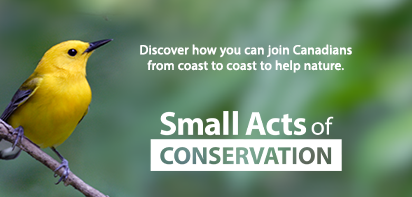A win for nature in Saskatchewan's Cypress Uplands
The Cypress Uplands is known for its scenic valleys and coulees and is a popular vacation destination. Efforts to safeguard this natural area are taking a leap forward thanks to the Nature Conservancy of Canada (NCC), a non-profit conservation group.
A total of 389 hectares (962 acres) are now being conserved in the Rural Municipality of Arlington, located in eastern part of the Cypress Hills area and include the following two properties:
- The Parker property contains 65 hectares of endangered Prairie grasslands, wetlands and aspen bluffs and the wildlife they sustain.
- Parker Coulee features 324 hectares of grasslands and wooded coulees, including the east-facing slopes of the Jones Creek Valley.
Wildlife commonly found in the area include pronghorn antelope, mule and white-tailed deer, elk and cougar. Cypress Uplands also holds the highest diversity of birds in Saskatchewan, including at-risk species, such as burrowing owl (endangered), chestnut-collared longspur (threatened), common nighthawk (threatened) and ferruginous hawk (threatened).
The conserved area not only serves as a refuge for wildlife, but also plays a pivotal role in ensuring the future of endangered ecosystems. Grasslands filter water, help mitigate floods and droughts, and store billions of tonnes of carbon. They have historically provided nourishment to communities and continue to be a cornerstone of Saskatchewan’s economy.
NCC wishes to acknowledge the generous donors and partners who made this work possible, including Barb and Doug Mader, MapleCross, Maria Spinato and the South Saskatchewan Community Foundation Inc. The Government of Canada provided support through the Natural Heritage Conservation Program, part of Canada’s Nature Fund. The Government of Saskatchewan contributed through the Fish and Wildlife Development Fund.
These projects exemplify a dedicated commitment to safeguarding grasslands under NCC’s Prairie Grasslands Action Plan — a comprehensive strategy aimed at conserving more than 500,000 hectares by 2030. This is an area six times the size of Calgary and equivalent to what we will lose if we don’t act now to protect the grasslands that remain. Learn more about how you can take action to care for Canada’s iconic Prairie grasslands at prairiegrasslands.ca.
Quotes
“These conservation projects, nestled in the breathtaking Cypress Uplands, are more than just a sanctuary for wildlife — they are a beacon of hope for endangered grasslands. Here, pronghorn, elk and at-risk species, like ferruginous hawk, find refuge, while the land itself plays a crucial role in water filtration, flood mitigation and carbon storage. By conserving such landscapes, we ensure a thriving future for both nature and communities. We urge everyone to join the mission of preserving Canada's Prairie grasslands.” – Michael Burak, Program Director in southwest Saskatchewan, Nature Conservancy of Canada
“This land here has been in my family since my grandfather came out here 120 years ago. At that time there was nothing but natural prairie everywhere; there hadn't been a plough in the country yet. So, I grew up around native grass and learned to appreciate it; It stays with you and becomes a part of who you are. Every year, I see more and more land just going under the plough and it's scary. We're losing all our native species, all the native flowers, everything that we're just so used to being a part of our life. We're lucky in this area because we've got a big area of it, but like I say it's disappearing. We have to try and save what we've got. I like the Nature Conservancy [of Canada] because its going to be here for a long time and that's what we need.” – Frank Parker, Land Steward, Parker Coulee Conservation Area
“Protecting Prairie grasslands not only preserves the defining landscapes of Western Canada but also safeguards species at risk, such as burrowing owl and ferruginous hawk. Additionally, these grasslands play a crucial role in naturally filtering water, mitigating floods and droughts, and storing carbon. Through partnerships with the Nature Conservancy of Canada (NCC) and initiatives like the Natural Heritage Conservation Program, we are making significant strides towards our goal of conserving 30 per cent of lands and waters in Canada by 2030." – The Honourable Steven Guilbeault, Minister of Environment and Climate Change
Facts
- The Prairie Grasslands Action Plan is a cross-country, $500-million campaign to conserve 500,000 hectares by the end of 2030.
- Partnership is at the heart of the plan. NCC is working with local communities and in collaboration with Indigenous Nations on a multitude of projects. We are partnering with industry, government and other conservation organizations to complete conservation projects on the ground. And we are advancing stewardship with ranchers, livestock producers and grazing groups to deliver solutions that ensure that grasslands remain a foundation for thriving communities.
- Grasslands, and the wetlands within them, are important stopover sites for migratory birds. They also provide habitat for waterfowl and imperilled species. The conservation of Canada’s remaining grasslands is essential to ensuring that at-risk species, including burrowing owl, ferruginous hawk and swift fox, survive.
- The agricultural sector relies on native pollinators to produce nutritional and economic benefits for people. Grasslands provide nesting sites, refuge and food for a diverse community of pollinators.
- Disturbances, such as grazing and fire, help restore and maintain the health of grasslands. Grazing and fire also create a mosaic of habitats across the grasslands, providing suitable conditions for a greater variety of plants and animals. Some species need shorter grass to survive, while others need longer grass.
Parker Conservation Area video: https://www.youtube.com/watch?v=o-eonXP9UO8
About
The Nature Conservancy of Canada (NCC) is the country’s unifying force for nature. NCC seeks solutions to the twin crises of rapid biodiversity loss and climate change through large-scale, permanent land conservation. As a trusted partner, NCC works with people, communities, businesses and government to protect and care for our country’s most important natural areas. Since 1962, NCC has brought Canadians together to conserve and restore more than 15 million hectares.
The Government of Canada’s Natural Heritage Conservation Program (NHCP) is a unique partnership that supports the creation and recognition of protected and conserved areas through the acquisition of private land and private interest in land. To date, the Government of Canada has invested more than $470 million in the program, which has been matched with more than $982 million in contributions raised by the Nature Conservancy of Canada, Ducks Unlimited Canada and the country’s land trust community, leading to the protection and conservation of nearly 800,000 hectares of ecologically sensitive lands.
Learn More
Follow us on on X (formerly Twitter): x.com/NCC_CNC | x.com/NCC_CNCMedia
Find us on Facebook
- 30 -




